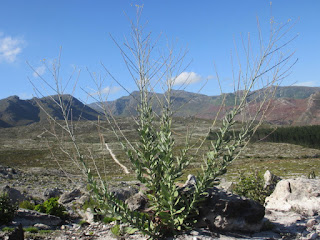Well, it was difficult to decide which flower was most impressive today, but after keeping us waiting quite a long time in the burnt area, the Watsonia schlechteri are out, with many more on their heels by the look of it!
Here is the flower up close.
Another we found will make a nice advertisement by next week for Oak Valley Flowers, whose hot-houses are in the background!
While many of the Corymbium glabrum var. glabrum are over, we're still finding them here and there, this was the most impressive, with buds still to open:
The five petals can be seen on the flowers here, and the ubiquitous bottle-blue bugs!
Here is a huge five-toothed Baboon Cabbage Othonna quinquedentata, it's about 6 feet tall and as wide.
For all that, the flowers are tiny! It can be seen below that it's a Daisy.
It was distressing to see that irresponsible four-wheel-drive vehicles have once again gone straight up the hill where late Brian du Toit and I made drainage run-offs to prevent washaways. There is now no control over access to the forest, the gates are left open. I suppose for some people, this is 'just another sand dune to be conquered'? It certainly does nothing to make me support either Westvaal or Isuzu!
Not far from the one we found last week, here is another small plant completely covered with these lilac five-petalled flowers. The stigmas are long, forked and 'recurving'. We just can't find a name for it! Could they be the endangered Merciera azurea?
Another view:
Despite showing this plant on last week's blog, none of you seem to have rushed up there to find something to smoke! Cannabis sativa?
Purple Powder-puff Pseudoselago serrata are to be found all over, this was the most impressive!
This was the only Chincherinchee Ornithogalum thyrsoides I saw, it still has many flowers to open.
We wanted to go back and check the Curlygrass fern, also called 'Comb fern'. It's easy to see why! Schizaea pectinata.
We don't often stop for a yellow daisy, there are so many. But this was particularly dark and the flowers were closing.
From the side:
And the whole plant. Any guesses?
The plants which are really coming into their own now are the rare Agapanthus walshii!
They don't often have as many florets as this, the buds are full!
We've never seen so many! This particular group is close to the 'red road' recently deforested. We would definitely have seen them before, but for the trees having been cut and the fire which followed.
The leaves don't amount to much but the stems are tall. These are more 'normal' flowers
So maybe I should have called this issue after the Aggies? :-) A






















I have not been reading for a while, but what a joy to catch up! Beautiful pics, thanks Andy and Pippa!
ReplyDelete:-)
ReplyDelete